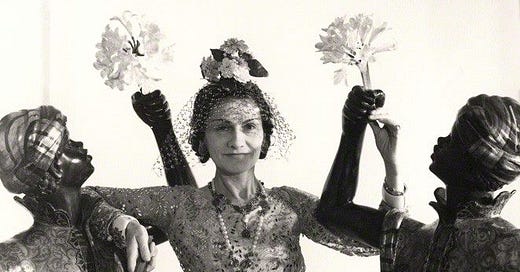Luxury and the black body
Essays on the commodification of black bodies, exploring Black, queer identities, celebrating Puerto Rican artistic excellence and welcoming our new Content Editor.
Hello everyone,
This week I have plenty to share with you, so I will be brief. As we wind things down during Black History Month and prepare for March (I cannot believe it’s almost March), you will find our friend and colleague Dr. Jonathan M. Square’s essays on the objectification and commodification of black bodies in luxury spaces, Research Assistant Kai Marcel’s explorations of Black, queer identity and self-expression, our latest addition to The Directory and the latest addition to our FRD team–Anthony Palliparambil, Jr.
Objects That Matter: ‘Interrogating the Presence of Blackamoors in High Fashion and Decorative Arts’

As part of our month-long research partnership with Holt Renfrew, Dr. Jonathan M. Square has written three essays that explore the most insidious and troubling trends in fashion history he’s uncovered so far.
As mentioned last week when I shared Dr. Square’s first essay (of three) on Diana Vreeland, I hinted at the history of blackamoors in fashion and the decorative arts. Not everyone knows what a blackamoor is and why it is significant, and I think that in itself warrants a lengthy, written piece on the database in the future.
But in the meantime, Dr. Square offers a brief introduction to blackamoors in fashion and the decorative arts by identifying and problematizing their presence in spaces of luxury. In his piece for Objects That Matter, he begins by showing you how blackamoors have been adopted by some of fashion’s elite, and he spends the second half of the piece showing you how Black artists are re-appropriating the blackamoor, interrogating its significance and re-writing narratives that dominated centuries past:
The ornamental use of blacks in European luxury fashion and decorative arts continues to appear periodically. Take, for example, Dolce & Gabbana’s infamous Spring/Summer 2013 collection, in which images of blackamoors were featured prominently on jewelry and clothing. Or, when Princess Michael of Kent, cousin of Queen Elizabeth II, wore a blackamoor brooch to a Christmas banquet at Buckingham Palace. Her wearing the brooch was particularly egregious, considering she was attending the event with the soon-to-be Duchess of Sussex Meghan Markle, who self-identifies as a woman of African descent.
'Objects That Matter' gathers numerous fashion objects outside of the Western lens and provides a brief history, showing why they matter, as many of these items have been widely appropriated or referenced.
Essay: ‘The Problem with All-Black Castings’

I think that an introduction to the presence of blackamoors in spaces of luxury provides a bridge into Dr. Square’s final essay, ‘The Problem with All-Black Castings’:
Occasionally, designers and creative teams make the provocative decision to cast only Black models for a fashion shoot, runway show, or campaign. In a world predicated on global white supremacy, white and lighter skinned people hold privileged, if not normative positions. The inclusion of people of color is, therefore, often not neutral. To cast only Black people is a radically political move. It too can also be used to create the allure of exoticism, to conjure a sense of camp and/or shock value, or worst, to shallowly evoke the values of inclusion.
Read on, as Dr. Square is critical of these common creative practices in the fashion industry.
A special thanks to retailer Holt Renfrew for making Dr. Jonathan Square’s research at The Fashion and Race Database possible.
Do you appreciate our content and research? Learn about our sponsorships or support us with a one-time or monthly, sustaining donation!
From The Library: Fashioning Black Queer Genders

This week, FRD Research Assistant Kai Marcel is thinking through the history of fashioning of Black, queer identities and has developed a reading list for your consideration:
Fashion and ‘fashioning’ remain crucial parts of gender expression and the performance of identity. Fashion’s potential to signify and convey identity in material form is comparable to the power of words to convey meaning in linguistic form. We all use this language of dress to signify our relationships to our gender identities, whether we do so consciously or otherwise, but what happens when the identities of some transgress the discursive boundaries of race, respectability, bionormativity, and cisheteronormativity?
These five sources explore this question in depth, as they share the personal, historical, and contemporary narratives of Black queer gender expression and self-fashioning. From the binary-breaking lwas of Haitian Vodou, to the signature white tie, top hat, and tails of Harlem Renaissance performer Gladys Bentley, these moments form a broad constellation of subversive and genderful expressions that continue to expand, develop, and refine our collective understanding of Blackness, gender, and possibility.
Ezili′s Mirrors: Imagining Black Queer Genders by Omise′eke Natasha Tinsley (Book)
Bulldaggers, Pansies, and Chocolate Babies: Performance, Race, and Sexuality in the Harlem Renaissance by James F. Wilson (Book)
If This Be Sin: Gladys Bentley And The Performance Of Identity by Moira Mahoney Church (Article/Thesis)
Fabulous: The Rise of the Beautiful Eccentric by Madison Moore (Book)
Butch Queens Up in Pumps: Gender, Performance, and Ballroom Culture in Detroit by Marlon M. Bailey (Book)
‘The Library’ is where we collect and organize countless educational sources all in one place. Referenced by educators, students, fashion enthusiasts and curious minds, this multi-faceted repository provides an expanding selection of tools for learning about all matters connected to fashion, appearance, power and the impact of ‘race.’
The Directory: The Antonio Archives
Newly added to our directory of resources is The Antonio Archives, an online archive that celebrates the life and career of one of fashion’s most beloved and recognized artists:
The Antonio Archives chronicles three decades of original works on paper, photography, and ephemera created by “Antonio,” the signature that represents the collaborative career of the Puerto Rican-American artists Antonio Lopez and Juan Ramos. Working together from 1961 until 1987 in New York, Paris, and beyond, the duo pioneered a new vision of American multiculturalism during a post-modern moment where art, fashion, and queer culture collided.
The discourse on fashion and race threads through a vast network of like-minded endeavors. ‘The Directory’ catalogues other sources of information and inspiration.
Announcement: Meet our new Content Editor
Although we are a small organization, I am grateful that we’ve had the capacity to expand our team, little by little. That said, I’m excited to introduce you to a colleague within my fashion studies community, Anthony Palliparambil, Jr.
When I was searching for a Content Editor last month, I immediately thought of one person, and that’s Anthony. Warm, organized, passionate about fashion, art and critical thought, Anthony understands what it will take to expand FRD’s content without compromising our mission. As Anthony and I put our heads together on new content to deliver in the coming weeks and months, here’s a bit more about Anthony (which you can also find on our Project Team page):
Anthony currently teaches in the school of Art and Design History and Theory at Parsons School of Design, where he received an MA in Fashion Studies. He also holds a BA in Studio Art from the University of Maryland, College Park, and is in the public art collections of the University of Virginia Children’s Hospital, West Virginia University, and the Inova Schar Cancer Institute. Anthony also serves on the editorial board of The Fashion Studies Journal. Learn more about Anthony on his website.
Welcome, Anthony!
That’s it for now. Please stay safe and we’ll see you next week.
Yours in service and solidarity,
Kim Jenkins
The Fashion and Race Database Team: Rachel Kinnard, Daniela Hernandez, Kai Marcel, Laura Beltrán-Rubio and Anthony Palliparambil, Jr.






